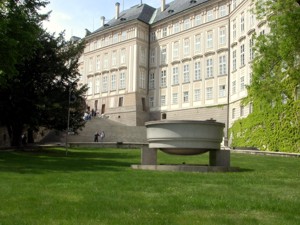
Plečnik created little in Prague, he did not want to take work from his Czech colleagues
 |
There are only a few buildings clearly known to be by Plečnik in the Czech Republic. From the period between 1911, when Plečnik arrived in Prague, and the early 1920s, there is only the so-called Kratochvíl Tomb in the cemetery at Křivoklát. Unfortunately, it was probably recently destroyed by vandals, Švácha noted. After that, Plečnik likely participated in a competition for the Žižka Monument on Vítkov in 1913 - this is a recent discovery, according to Švácha. An expert on Plečnik's work and a former Slovenian ambassador to the Czech Republic, Damjan Prelovšek, attributes another small commission to him in one of his publications about the architect - the pedestal for the bust of manufacturer Josef Schroll in Broumov.
Czech architects first met the Slovenian colleague in Vienna at Otto Wagner's school, where he was a classmate of Jan Kotěra, for example. Kotěra wrote an article about Plečnik for the journal Volné směry at the beginning of the 20th century. This made Plečnik known even on the Czech scene back then, Švácha recalled. According to him, Plečnik's popularity in the Czech lands was also influenced by significant patriotic and pan-Slavic moments at that time - Plečnik was also a Slavic person like the Czechs.
In 1910, Jan Kotěra left the then School of Applied Arts in Prague for the Academy of Fine Arts, where he established a separate school of architecture - with the help of the then-member of the Vienna parliament, Masaryk. Plečnik took over the vacancy left by Kotěra.
Among Plečnik's first significant students were Josef Štěpánek and František Lydie Gahura, who later became a notable architect in Zlín, Bedřich Feuerstein, a significant pioneer of purism in the 1920s and a member of Devětsil. Another one of his students was Karel Řepa, a prominent architect in Pardubice, Ludvík Hilgert, the creator of functionalist buildings in Wallachia, and Alois Metelák, who later became the director of the glass school in Železný Brod and is considered a pioneer of Czech modern artistic glassmaking. "He had really many significant students. Otto Rothmayer, who took over the work at the Castle after Plečnik, must also be included among them," added Švácha.
According to Švácha, Plečnik required his students to some extent to adopt his style. However, the historian also reminds us that the Slovenian's style was hard to imitate - essentially, no one else could do it but him. "It was an interesting neoclassicism with distinctive moments that stemmed from his fondness for early Christianity - he himself was a deeply religious Catholic - or the art of the Etruscans, which he embraced and used Etruscan ornamentation in his buildings," says Švácha.
In addition to the romantic theory about the kinship of Slavs and Etruscans, Plečnik also admired the teachings of the most important theorist of that time, Gottfried Semper, from whom he adopted the theory of some carpet-like character of facades. "Semper taught that facades originated from the stylization of carpets, and he claimed that prehistoric rulers used to hang carpets on their tents, and from that, architecture developed. Plečnik believed that, and it is somewhat visible in his architecture - on the facade of the Church of the Most Sacred Heart of Our Lord in Vinohrady, there is a noticeable carpet-like facade and textile motifs," says the historian.
Although the church is admired by experts, and the Ministry of Culture has now even included it among the monuments it wants to strive for their inclusion in the UNESCO list, Švácha believes that Plečnik's work in the Czech Republic has more important adaptations of Prague Castle. "The significance lies primarily in the commission, the fact that the architect addresses the entire environment, the entire landscape around the Castle, not just isolated buildings. There are few parallels to this in the domestic context," he stated.
It is not entirely clear how President Masaryk came across Plečnik. Initially, he commissioned Kotěra to repair the Castle, whose drawings exist. However, according to art historian Jana Horneková, these designs were not liked by the president's daughter, Alice Masaryková. "They were somewhat in the art deco style, she found it too fashionable, and in the end, the commission was given to Plečnik, who had more recommendations, including from the Mánes association," said Švácha. Plečnik began working at the Castle in 1920. The adaptations he left to Otto Rothmayer and later Pavel Janák were completed only after World War II.
The situation with the commission for the Vinohrady church was similar to that of the Castle. The competition announced around 1920 was won by Plečnik's students with a project that repeated typical Plečnik themes. In the end, the client also approached Plečnik directly - partly because he had a warm relationship with the Catholic Church. "The somewhat delicate thing is that President Masaryk was not a Catholic, and Plečnik is building a Catholic church in Prague. But President Masaryk was generous," concluded the historian.
> Josip Plečnik changed Prague Castle and the appearance of his native Ljubljana [4.1.2007]
 |
| Kotěra/Plečnik - correspondence picture |
VŠUP, 2001
Our price: 238 CZK (dispatch time: up to 7 days)
 |
 |
| Josip Plečnik - life and work picture |
ERA publishing house, 2001
Our price: 700 CZK (dispatch time: up to 7 days)
 |
 |
| Josip Plečnik picture |
Administration of Prague Castle, 1996
Our price: 2,808 CZK (dispatch time: up to 7 days)
 |
The English translation is powered by AI tool. Switch to Czech to view the original text source.
0 comments
add comment










